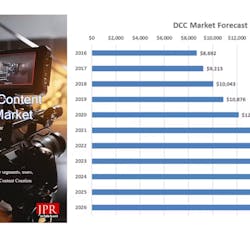According to ABI Research, revenues from the emerging TV as a service (TVaaS) business model will grow from 10% in 2016 to 35% of video software revenues in 2021. The TVaaS model states that recurring revenues based on video consumption, transactions or subscriber-related metrics will take over traditional hardware sales, software and IP licenses, and service-related revenues. TVaaS opportunities are expected to grow to $1.5 billion in 2021.
"Companies that wish to succeed in the TVaaS realm need to commit to customer-oriented solutions, including investing in 24/7 operational capabilities and robust engineering organizations," said Sam Rosen, managing director and vice president at ABI Research. "Solutions need to support the hybrid cloud methodology where they can be deployed in public cloud infrastructure, as well as customer's own data centers. Also important to operators is the use of microservice-based architectures that allow larger customers to adopt one or two components of a solution around a specific pain point."
Most major vendors now demonstrate products with TVaaS components. Major examples include Cisco's Infinite Video suite, Nagra's intuiTV product, and Ericsson's MediaFirst suite. Similar TVaaS trends are also occurring in product lines outside of middleware, including digital rights management (DRM), guide licensing and metadata, transcoding and QoE measurement.
In terms of readiness to transition to TVaaS architectures and business models, DRM leads the movement at a 56% transition rate by 2021, followed by transcoding and its 36% transition rate within the same time. Middleware, as well as guide licensing and metadata, are expected to transition to 20% and 12%, respectively.
"Video software markets are in a period of rapid disruption, highlighted most aggressively by Ericsson's revelation that its media unit's operating income showed a loss of 25% of revenues in 2016, accelerating to 33% in the fourth quarter," said Rosen. "To survive the upheaval, these markets must adopt models that showcase a unique balance of service-oriented integration and development offerings, intellectual property (IP) licensing, traditional software licensing and TVaaS."





